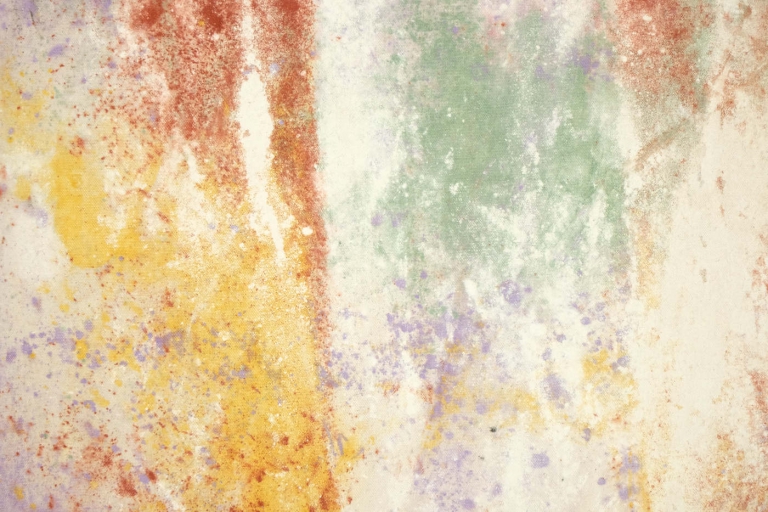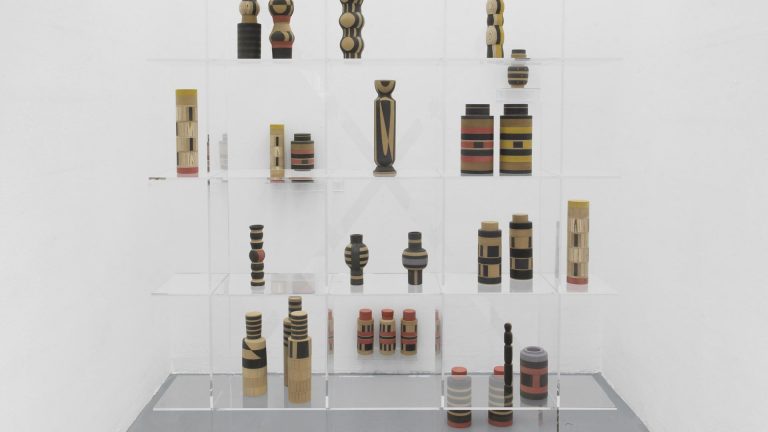Artist: Jasmin Werner
Exhibition title: Seniorita Latifa Sharifah
Venue: Galerie Guido W. Baudach, Berlin, Germany
Date: September 11 – October 16, 2021
Photography: Roman März, all images copyright and courtesy of the artist and Galerie Guido W. Baudach, Berlin
Galerie Guido W. Baudach is delighted to present its first solo exhibition with Cologne-based German-Filipino artist Jasmin Werner. On display are two brand-new series of assemblage-like sculptures of her usual peculiar materiality which are as allusive as cryptically titled Wholly Family and Schloss der Republik Burj Khalifa OFW. The following text by Dubai and New York-based writer Rahel Aima not only describes the works, but also provides a very personal introduction to their broader context.
Around the time I learned to drive, sometime in the mid-2000s, a very large billboard went up in Dubai. It was emblazoned with the phrase “His-tory Rising” and faced the highway, as these things do. To travel along the city’s arterial Sheikh Zayed Road is to see the billboards flashing the future before your eyes: new megadevelopments, like property ladders to heaven; fancy cars; and the latest smartphones, all exclusively featuring smiling white and Arab faces. Only during Diwali, the Hindu festival of lights, would we see the South Asians who make up the majority of the population, in the form of Bolly/Lolly/Tollywood stars advertising gold jewelry. Absent entirely are Overseas Filipino Workers or OFWs. Behind all the signage are nesting-doll-like layers of fencing, scaffolding, mesh, and netting and so many cranes, all protectively encircling reinforced concrete shells.
Jasmin Werner’s Schloss der Republik Burj Khalifa OFW works have the same feel. The mesh is printed with building facades and hugs the scaf-folding like a dancer’s port de bras, while backlighting reminds us of the gossamer-thin liminal space—the Barzakh, in Islamic eschatology — between one world and the next. Photographs taken by Werner‘s Filipina cousin, an OFW herself, bespeak the lives behind all those screens and glass: the ubiquitous ground floor hair salon, for example, or the maximalist, curlicued style of decoration. In between these spatially imposing sculptures that rise like the scaffolding of a construction site, cheery plastic shopping trolleys hide extension cords even as they remind us that after peak oil comes peak plastic.
Dubai is a funny kind of place, where the future feels more certain than narratives of the past, which have been erased and rewritten so many times that they take on a palimpsestic quality. It is a city built with aeriality in mind, designed to be seen through a drone’s eye view, or from the Moon (and soon, Mars). A trio of austere ladder sculptures captures this yearning verticality, through assemblages of gleaming steel, plastic vegetables, and beaded, chandelier-like tops that suggest nothing so much as sombrero hats even as they refer to Pinoy sacred objects. One
sculpture in particular, Wholly Family V, which boasts some rather construction-crane-like legs, says nothing so much as Howdy. I’m the sheriff of rewriting history.
I was a nervous driver but always craned my neck to see that gigantic billboard. It featured a glossy rendering of the Burj Dubai surrounded by dancing fountains and dwarfing all the other buildings around it. Like the COVID-19 bar graphs so common today, the building was so tall that it exceeded the rectangular frame, its metal cylinders jutting elegantly into the sky. Behind it, the world’s tallest building slowly grew. During the financial crash, Dubai would have to be bailed out by neighboring Abu Dhabi. The Burj Dubai was renamed the Burj Khalifa, after its new benefactor.
That this paean to capitalist excess was built with steel girders from Berlin’s demolished German Democratic Republic-era Palace of the Republic seems right somehow. So does the Palazzo Prozzo’s replacement institution, the Humboldt Forum, which has become a flashpoint in the debates around the restitution of looted colonial objects. It is nice to think of anything, even inanimate metal, getting a second chance at life, in this case with sunshine and a killer view. And it is even more fitting that Werner’s new Burj Khalifa series and the pedestals upon which the ladder sculptures sit are themselves recycled from an older pair of City Palace-Burj Khalifa works shown outdoors in 2019 at the communal gallery Bärenzwinger, sited in Berlin’s former bear pits. In a few hundred years, assuming that climate change allows us to live that long, what will the Burj Khalifa be recycled into?
Germany may send high-grade socialist steel; other countries send their workers, and in turn these workers send back so many Gulfy goods. In 1990s Kerala, where much of Dubai’s population comes from, this might have meant bottles of space-age orange drink mixes and powdered milk, electronics, and luridly patterned plush blankets, an immigrant symbol as universal as the left arm scar of tuberculosis vaccinations that are present on everyone over a certain age. For people from the Philippines, this might take the form of the balikbayan box, the country‘s own variant of the care package. For most, it takes the form of monetary remittances to support your family at home, cash and dreams of a reunited future cast yellow under a glowing Western Union sign.
– Rahel Aima
Jasmin Werner born in Troisdorf 1987, studied at HfG Karlsruhe, Rietveld Academy Amsterdam and Städelschule Frankfurt and has since participated in various exhibitions at home and abroad, such as Unschuldsengel, Project room of Westfälischer Kunstverein, Münster, 2021 (solo); Façadomy, Damien & The Love Guru, Brussels, 2020 (solo); The Wheel of Life Remise, Kunstverein Braunschweig, 2020 (solo); Musée sentimentale de l’ours de Berlin, Bärenzwinger, Berlin, 2020; RAW, DuMont Kunsthalle, Cologne, 2019; Ein Pfund Orangen, Kunstverein Ingolstadt, 2019; The same as ever, but more so, Braunsfelder, Cologne, 2018; 19 positions, Folkwang Museum, Essen, 2017; Status Faux, Gillmeier Rech, 2017 (solo).
In 2017, Jasmin Werner completed a residency at National Museum of Modern and Contemporary Art, Seoul.
Jasmin Werner, Seniorita Latifa Sharifah, 2021, exhibition view, Galerie Guido W. Baudach, Berlin, Courtesy the artist & Galerie Guido W. Baudach Photo: Roman März
Jasmin Werner, Seniorita Latifa Sharifah, 2021, exhibition view, Galerie Guido W. Baudach, Berlin, Courtesy the artist & Galerie Guido W. Baudach Photo: Roman März
Jasmin Werner, Seniorita Latifa Sharifah, 2021, exhibition view, Galerie Guido W. Baudach, Berlin, Courtesy the artist & Galerie Guido W. Baudach Photo: Roman März
Jasmin Werner, Seniorita Latifa Sharifah, 2021, exhibition view, Galerie Guido W. Baudach, Berlin, Courtesy the artist & Galerie Guido W. Baudach Photo: Roman März
Jasmin Werner, Seniorita Latifa Sharifah, 2021, exhibition view, Galerie Guido W. Baudach, Berlin, Courtesy the artist & Galerie Guido W. Baudach Photo: Roman März
Jasmin Werner, Seniorita Latifa Sharifah, 2021, exhibition view, Galerie Guido W. Baudach, Berlin, Courtesy the artist & Galerie Guido W. Baudach Photo: Roman März
Jasmin Werner, Seniorita Latifa Sharifah, 2021, exhibition view, Galerie Guido W. Baudach, Berlin, Courtesy the artist & Galerie Guido W. Baudach Photo: Roman März
Jasmin Werner, Seniorita Latifa Sharifah, 2021, exhibition view, Galerie Guido W. Baudach, Berlin, Courtesy the artist & Galerie Guido W. Baudach Photo: Roman März
Jasmin Werner, Seniorita Latifa Sharifah, 2021, exhibition view, Galerie Guido W. Baudach, Berlin, Courtesy the artist & Galerie Guido W. Baudach Photo: Roman März
Jasmin Werner, Seniorita Latifa Sharifah, 2021, exhibition view, Galerie Guido W. Baudach, Berlin, Courtesy the artist & Galerie Guido W. Baudach Photo: Roman März
Jasmin Werner, Schloss der Republik Burj Khalifa OFW III, 2021, shuttering props, LED Spotlight, threaded rods, screws, nuts, aluminium, backlit foil, plastic foil, printed mesh fencing
300 x 81 x 82 cm, Courtesy the artist & Galerie Guido W. Baudach Photo: Roman März
Jasmin Werner, Schloss der Republik Burj Khalifa OFW II, 2021, LED Spotlight, threaded rod, screws, nuts, aluminium, backlit foil, plastic foil, printed mesh fencing 114 x 82 x 53 cm, Courtesy the artist & Galerie Guido W. Baudach Photo: Roman März
Jasmin Werner, Schloss der Republik Burj Khalifa OFW IV, 2021, LED Spotlight, threaded rods, screws, nuts, aluminium, backlit foil, plastic foil, printed mesh fencing 114 x 81 x 29 cm, Courtesy the artist & Galerie Guido W. Baudach Photo: Roman März
Jasmin Werner, Wholly Family III, 2018, metal ornament (halo), toy corn, wood, aluminium, threaded rod 60 x 34 x 28 cm, Courtesy the artist & Galerie Guido W. Baudach Photo: Roman März
Jasmin Werner, Wholly Family IV, 2021, aluminium, wood, bottle brush, apple, plaster, ink pen, coloured crayon, threaded rod, nut, toy fruit and vegetables, metal ornament (halo), 58 x 39 x 17 cm, Courtesy the artist & Galerie Guido W. Baudach Photo: Roman März
Jasmin Werner, Wholly Family V, 2021, aluminium, wood, bottle brush, plaster, ink pen, apple, plaster, threaded rod, nut, zip tie, toy vegetables, metal ornament (halo), 76 x 34 x 20 cm, Courtesy the artist & Galerie Guido W. Baudach Photo: Roman März
Jasmin Werner, Schloss der Republik Burj Khalifa OFW V, 2021, shuttering props, LED Spotlight, threaded rod, screws, nuts, aluminium, stone, wood, spray paint, backlit foil, plastic foil, printed mesh fencing, 285 x 82 x 87 cm, Courtesy the artist & Galerie Guido W. Baudach Photo: Roman März
Jasmin Werner, Schloss der Republik Burj Khalifa OFW I, 2021, LED Spotlight, threaded rod, screws, nuts, aluminium, backlit foil, plastic foil, printed mesh fencing 114 x 82 x 32 cm, Courtesy the artist & Galerie Guido W. Baudach Photo: Roman März
























